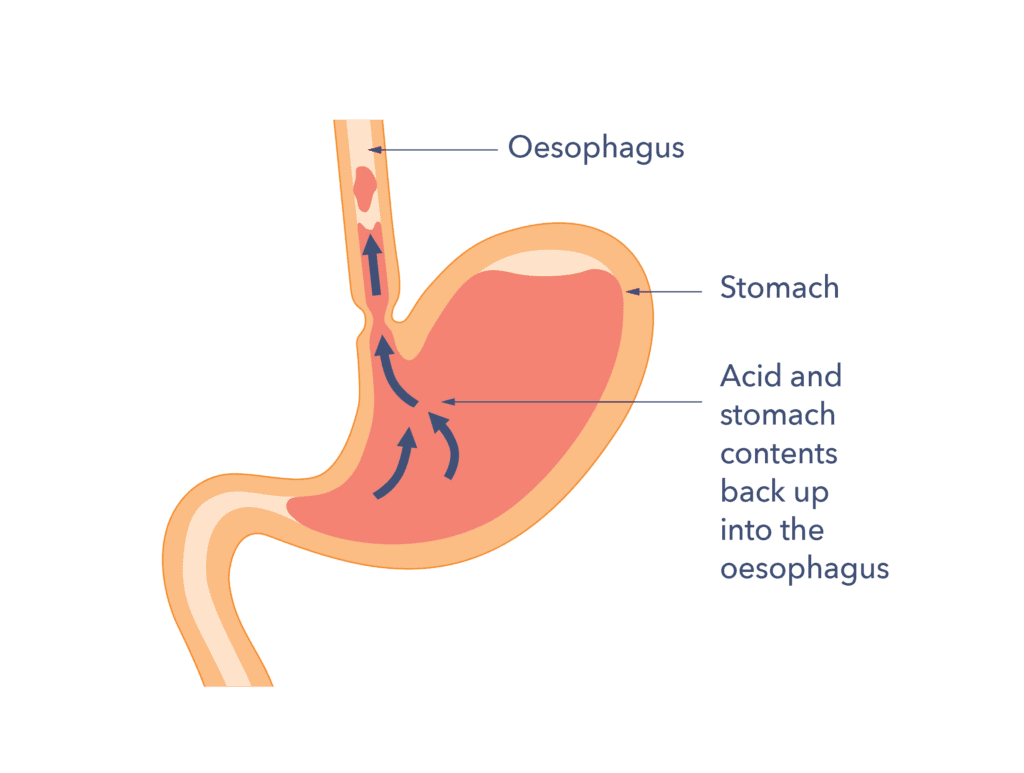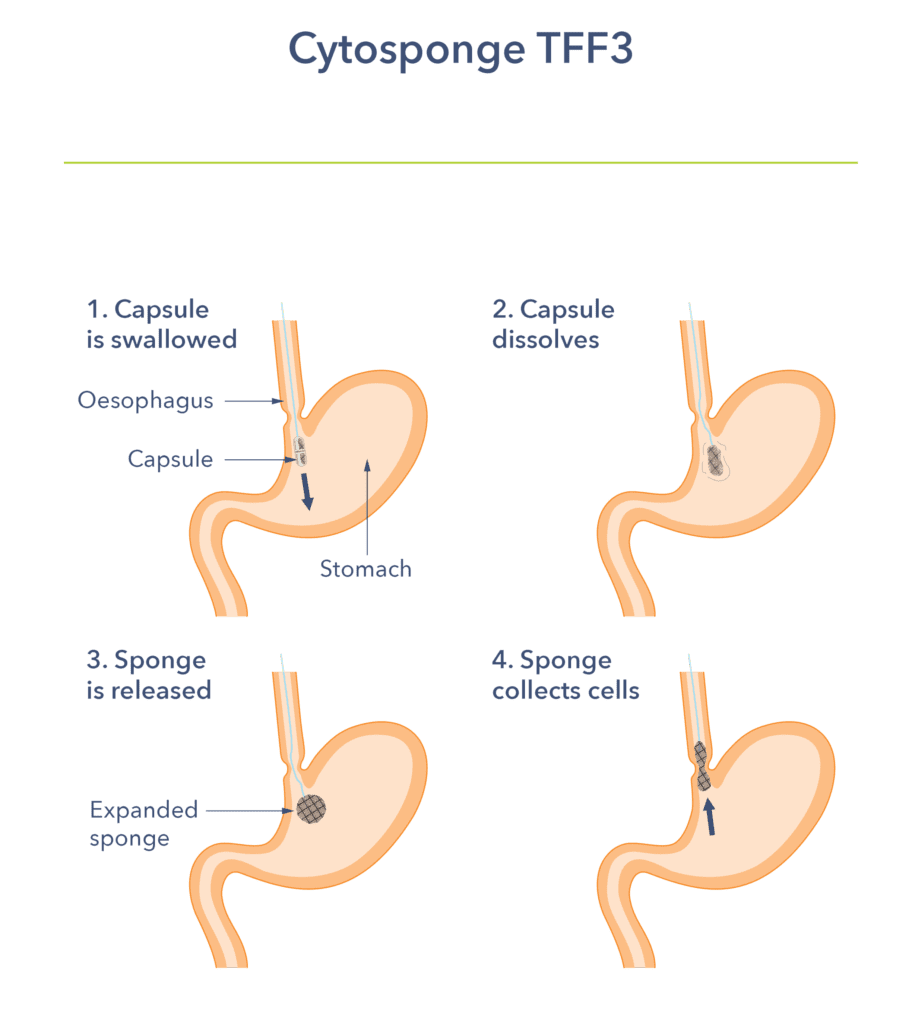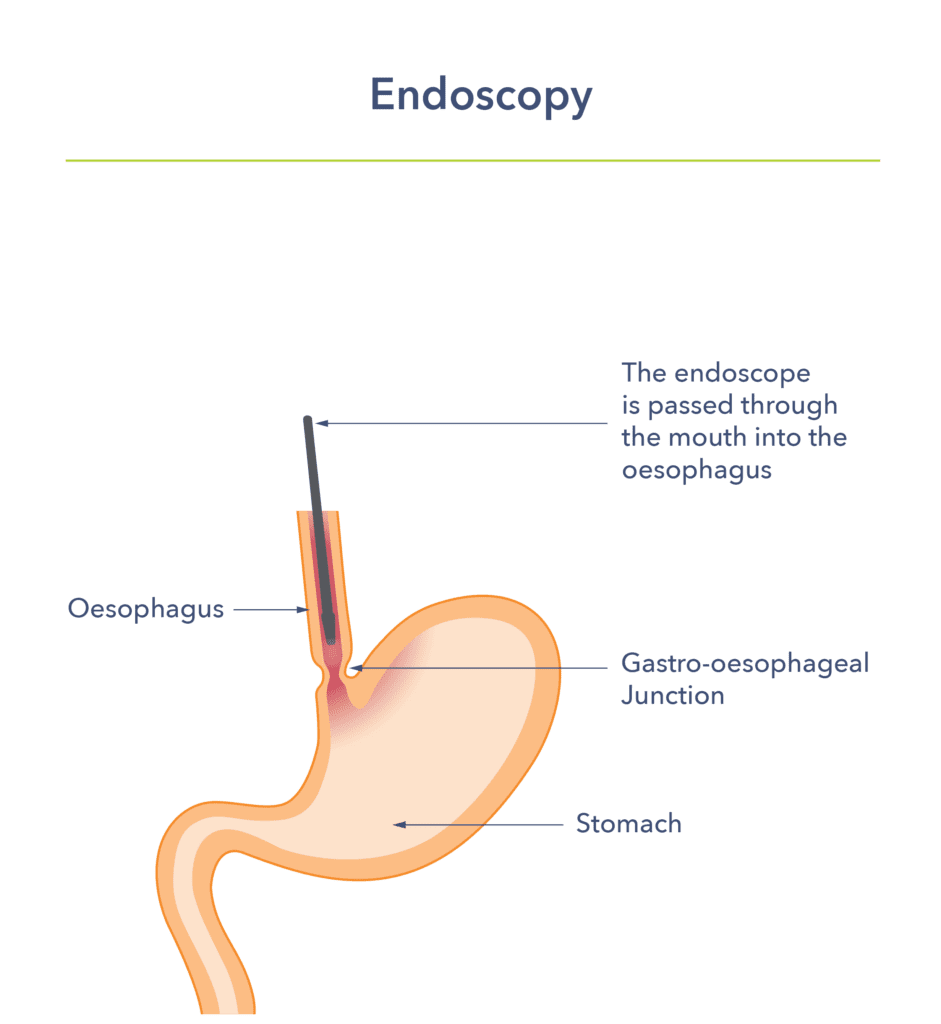Barrett’s Oesophagus
Download printable versionOverview
Barrett’s oesophagus is the term used for a potentially pre-cancerous condition where the normal cells lining the oesophagus, also known as the gullet or food pipe, have been replaced with abnormal cells.
The abnormal cells start from where the oesophagus meets the stomach and spread upwards. The main concern is that a small number of people with Barrett’s oesophagus will develop oesophageal cancer, though the majority will not.
Causes
Causes of Barrett’s Oesophagus
Although the exact cause remains unknown, it is strongly associated with long-term Gastro-Oesophageal Reflux Disease (GORD), which can cause the symptom of heartburn. Approximately 1 in 10 patients with GORD will develop Barrett’s Oesophagus and the risk increases with length and frequency of symptoms. GORD involves reflux of acidic and non-acidic stomach (gastric) contents into the oesophagus, which irritates (inflames) and injures the lining (epithelial cells).

See our information on Heartburn and Relux for more information on GORD.
Over time, in some patients with GORD, the lining of the oesophagus changes from the normal structure, made up of a type of cells known as “squamous epithelial” cells, to an abnormal type made up from a different type of cells, known as “columnar epithelial” cells. Often (but not always) the lining of the oesophagus starts to resemble the lining of the stomach, in a process known as intestinal metaplasia.
Other risk factors that can lead to Barrett’s Oesophagus include older age, male sex, family history, obesity, smoking, and a hiatus hernia (where the stomach extends abnormally from the abdomen into the chest). Barrett’s Oesophagus can affect men and women, though it is significantly more common in white men, who have a three fold increased risk for the condition.
Symptoms
The main symptom of Barrett’s Oesophagus is reflux, which can cause heartburn, regurgitation of food (bringing food back up), nausea and pain in the upper abdomen. You may also experience a metallic taste in your mouth or a chronic sore throat particularly in the mornings as reflux is usually worse after a period spent lying down. Reflux symptoms that wake you at night time are a particularly strong risk factor. Often though, patients with Barrett’s oesophagus do not report symptoms, or manage with over the counter antacids, and this can lead to delay in diagnosis.
Diagnosis
Cytosponge TFF3
This is a new test that is available in some areas of the UK to identify Barrett’s
oesophagus in people who have persistent heartburn and reflux symptoms. For the Cytosponge test you will be asked to swallow a small capsule with a sponge inside (see below), which is attached to a piece of thread. Approximately 7 minutes after swallowing it, the capsule dissolves in the stomach, and the sponge inside is released. A nurse will then gently pull the thread to remove the sponge. On the way out the sponge collects cells from the lining. The cells are then examined in the laboratory to check if there are any changes in the cells using a special stain called TFF3. If this does show cell changes you will then be asked to attend for an endoscopy to confirm whether there is Barrett’s present (see below).

Endoscopy
Barrett’s oesophagus is diagnosed by examining the oesophagus lining using
a procedure called endoscopy. This is a test performed by a specialist where a
small tube (the width of a small finger), with a camera on the end is inserted into the oesophagus and stomach via the mouth or nose. Sedation can be used to make the procedure more comfortable. The area of interest is where the oesophagus meets the stomach (gastro-oesophageal junction).
Barrett’s oesophagus is identified when, instead of a normal whitish lining, a
pinker lining is seen that extends from the junction and up the oesophagus. Biopsies (a small sample of tissue) are then taken to confirm diagnosis and look for abnormal cells (dysplasia). A pathologist will grade the dysplasia into high grade or low grade. If low grade dysplasia is found, then a repeat endoscopy in 6 months is ordered to reassess and consider if referral to a specialist centre for treatment is needed. Patients found to have high grade dysplasia are typically referred more quickly to a specialist centre, as the risk of progression to cancer is higher.

How does Barrett’s Oesophagus affect you over time?
Some patients with Barrett’s oesophagus may have good control of symptoms, but some patients may experience worsening symptoms, and may need surgical treatment despite medications. 3 in 1000 people to 6 in 1000 people may develop oesophageal cancer per year which is a lifetime risk of 7.5-12.5% depending on several risk factors including how long Barrett’s has been present.
What impact can Barrett’s Oesophagus have on your life?
The diagnosis of Barrett’s Oesophagus can affect a person in many ways. These include the complications of the condition and its overall impact on general wellbeing due to the symptoms and fear of cancer. Complications include:
- Development of cancer of the oesophagus: Symptoms to watch out for include persistence of reflux, difficulty swallowing, unexplained weight loss, bringing up blood or change in voice. If any of these are experienced, then a doctor should be consulted. Further tests may be carried out and if cancer is detected, it may be treated endoscopically, with surgery or with chemotherapy, depending on the stage of the cancer (the stage of a cancer describes how big the tumour is and how far it has grown).
- Narrowing of the oesophagus (strictures): These can create difficulty swallowing and sometimes weight loss due to decreased food intake. Strictures can be treated by dilating them during endoscopy. Barrett’s oesophagus can affect your life in the short and long term via day-to-day symptoms (see above) and treatment side effects, added to which there is also the ongoing fear of developing cancer. All of these things can cause major upset, frustration and feelings of hopelessness. If you are experiencing any of these feelings, it is important to let the doctor know so that appropriate support can be offered. In addition, many specialist centres run nurse-led patient groups where you can exchange information, advice and support one another.
Treatment
Barrett’s Oesophagus with Dysplasia (abnormal cells)
The treatment for Barrett’s Oesophagus has changed significantly over recent years. Previously patients with dysplasia were either monitored more closely (intense surveillance) until cancer was found or referred for surgery to remove the oesophagus. Removal of the oesophagus (oesophagectomy) is a major operation however and is increasingly now only used for patients who have cancer. The introduction of minimally invasive endoscopic therapy to remove or treat the segment of oesophagus affected by Barrett’s has transformed how the condition is managed particularly in the early stages. Usually performed at specialist centres with a treatment procedure is carried out during the endoscopy.
The procedure used will be selected depending on a variety of factors, most
importantly the stage and location of the affected cells.
Endoscopic Mucosal Resection (EMR)
This is a technique for removing small polyps or growths from the lining of the
oesophagus (gullet), stomach or first part of the small bowel (duodenum). This
technique enables the endoscopist to remove a larger area of tissue than is possible with a simple biopsy.
EMR is able to assess the abnormal Barrett’s tissue more accurately than a standard biopsy, so gives more information about the treatment that is right for you. As well as providing more information, the EMR also treats the abnormal area by removing pre-cancer cells, or small areas of cancer, without the need for major surgery. When EMR is performed there is a risk (approximately 1 in 50) of bleeding. If bleeding does occur it will usually stop by itself, but observation and further treatment in hospital may be necessary. Rarely (approximately 1 in 200 cases) a small hole in the lining of the area removed can develop (perforation). If this happens it would mean a stay in hospital for antibiotics and artificial feeding and possibly an operation to repair any damage. After the procedure the removed area will form a scar and heal, and it is quite common to get some chest discomfort and pain on swallowing for the first 2-3 days. If this continues, or you find it difficult to swallow food, then the scar may have caused a narrowing of the oesophagus. This occurs in approximately 1 in 20 patients, and can be treated with an endoscopy to stretch the scar.
Radiofrequency ablation (RFA)
This is a technique that enables the endoscopist to burn away the abnormal
cells. It is carried out under sedation and is very safe and effective in removing abnormal cells, but can only be used in flat areas, so will often be used after EMR has removed any raised areas. The technique is often referred to as HALO® RFA or Barrx®, after the manufacturers of the device. There are different types of devices, the most common have an attachment called 90 and 360. Your doctor will decide which is best to use depending on various factors. The 360 device treats the entire wall of the oesophagus (i.e. the full 360° circumference of the oesophagus wall). The 90 device is similar but treats a smaller area (i.e. a surface of the oesophagus wall equivalent to a 90° angle). Patients are usually treated with the 360 device, initially and if, at the next endoscopy, there is any abnormal lining left, they are treated with either the 360 or 90 device, depending on how large the affected area is. It is not unusual for patients to need several treatments to remove the Barrett’s entirely. Radio frequency ablation has been widely used for years in the UK, America and Europe for Barrett’s oesophagus, and is now recommended as the first line (preferred) technique in the UK for high grade dysplasia and has recently been approved by NICE for low grade dysplasia as well.
Photodynamic Therapy
This has mainly been replaced by HALO® RFA and is seldom used.
Barrett’s Oesophagus Without Dysplasia
A patient without dysplasia would be considered low risk. There are certain
exceptions that may warrant treatment (very long segment of Barrett’s or a strong family history of cancer) but these need to be discussed with a specialist. Patients without dysplasia may be treated as follows, although it must be noted that these non-surgical and surgical treatments do not remove the Barrett’s oesophagus and therefore, do not eradicate the risk of developing oesophageal cancer.
Medications: the most commonly used medications in the treatment of Barrett’s Oesophagus are Proton Pump Inhibitors (PPI). Omeprazole and lansoprazole belong to this group (though there are others). They work by reducing acid production in the stomach, which naturally reduces the acid refluxing into the oesophagus. Clinical research into other medication to reduce risk of cancer progression (chemoprevention), such as aspirin and statins, is ongoing.
Lifestyle changes: these all focussed on reducing acid reflux and include weight loss, reduction in alcohol intake, stopping smoking, reducing portion sizes and avoiding eating within three hours of going to bed.
Surgical options: If medication and lifestyle interventions do not help, a surgical procedure called a laparoscopic Nissen fundoplication may be carried out. This is where the upper part of the stomach is wrapped and stapled around the lower oesophagus.
Does Barrett’s Oesophagus need to be monitored and, if so, how?
Monitoring Barrett’s Oesophagus is a vital and lifelong part of treatment. This is because even if no dysplasia is found on biopsy at one endoscopy, this does not mean the patient will never get dysplasia or cancer in the future.
Patients are usually entered into a surveillance programme which ensures regular and appropriate monitoring, usually by endoscopy, although this does depend on fitness and other medical risk factors. The frequency of surveillance endoscopy varies from person to person and is based upon the type and length of the abnormal lining seen. In cases where no dysplasia cells are seen endoscopy may only be needed every 2-5 years. Those with very long segments of Barrett’s (over 10cm) are also often referred to specialist centres as this means an increased risk of the development of oesophageal cancer.
Support
What to ask your doctor?
- May I be referred to a dietitian to see if there are any changes to my diet that may help with my symptoms?
- Are there any other medications I can try? If not, am I suitable for surgery?
- How often do I need an endoscopy?
- Is my ongoing surveillance appropriate?
- Is there a Barrett’s Oesophagus patient support group or specialist nurse in my area?
Research
Several research areas are needed to improve the treatment of Barrett’s oesophagus. Early diagnosis is a key strategy in cancer research, and work using non-endoscopic methods to find Barrett’s include saliva biomarkers and breath testing as well as the newly introduced Cytosponge©. Blood markers for identification of Barrett’s oesophagus are also being considered but much more research and trials are needed before these can be used.
There is also work needed to assess more accurately which patients are likely to progress to cancer, improving the quality of surveillance endoscopy and the improving access to specialist centres for treatment.
Help us to continue to fund life-changing research by donating today.LEARN MORE:
Copyright © 2025 Guts UK. This leaflet was published by Guts UK in 2021 and is currently under review. The leaflet was written by Guts UK and reviewed by experts in Barretts Oesophagus and has been subject to both lay and professional review. All content in this leaflet is for information only. The information in this leaflet is not a substitute for professional medical care by a qualified doctor or other healthcare professional. We currently use AI translation tools on our website, which may not always provide perfect translations. Please check for further explanation with your doctor if the information is unclear. ALWAYS check with your doctor if you have any concerns about your health, medical condition or treatment. The publishers are not responsible or liable, directly or indirectly, for any form of damages whatsoever resulting from the use (or misuse) of information contained or implied in this leaflet. Please contact Guts UK if you believe any information in this leaflet is in error.



